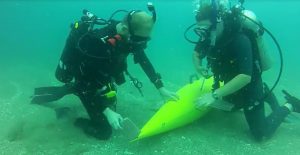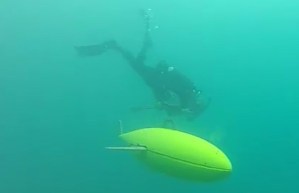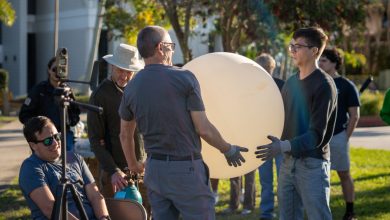Scuba Diving and Ocean Engineering
Scuba Diving and Ocean Engineering – by Dr. Stephen Wood – whether you need to dive to deploy some ocean device (e.g., ocean energy system, scientific equipment/instrument or underwater vehicle) or dive to obtain data (e.g., underwater archaeological information) at Florida Institute of Technology (Florida Tech) you will need to be AAUS certified. The American Academy of Underwater Sciences (AAUS) sets standards for scientific diving throughout the United States of America and since 1951 the scientific diving community has endeavored to promote safe, effective diving through diver training and education programs. The AAUS manual was modified to meet additional requirements and regulations of Florida Tech. Certain types of advanced diving practices allowed under AAUS are prohibited from Florida Tech diving operations, and specific university requirements have been added to the basic manual. It is the responsibility of every member of the AAUS and divers at Florida Tech to see that it always reflects state of the art, safe diving practice.
The purpose of Scientific Diving Standards is to ensure that all scientific diving is conducted in a manner that will maximize protection of scientific divers from accidental injury and/or illness, and to set forth standards for training and certification that will allow a working reciprocity between organizational members. Fulfillment of the purposes shall be consistent with the furtherance of research and safety. Scientific diving is defined as diving performed solely as a necessary part of a scientific, research, or educational activity by employees whose sole purpose for diving is to perform scientific research tasks, which is precisely what ocean engineers do while at Florida Tech. Below are a just few of the tasks and responsibilities to the AAUS accreditation.
Every research dive has a Project Director. Dive Projects at Florida Tech are conducted for purposes of research, academic classes, or dive training. The faculty member in charge of each research program, academic class, or dive training activity is designated as the Project Director, and is responsible for management of all aspects of the dive project. The Project Director is responsible for the submission of a Project Approval Form to the Dive Safety Officer (DSO) at least one week prior to the date of the first dive. The Project Director verifies with the Diving Safety Officer that the project has been approved and that a project approval number has been assigned. If the Project Director is not a diver or will not be present at the dive site, the Project Director appoints a Lead Diver who is then approved by the Diving Safety Officer. The Project Director is responsible for management of all aspects of the dive project. At the end of each project, the Project Director files an End of Project Form. This form summarizes the diving operations and close out the project.
is then approved by the Diving Safety Officer. The Project Director is responsible for management of all aspects of the dive project. At the end of each project, the Project Director files an End of Project Form. This form summarizes the diving operations and close out the project.
Every research dive has a Lead Diver. For each dive, one individual is designated as the Lead Diver who will be at the dive location during the diving operation. The Lead Diver is responsible for coordination with other known activities in the vicinity that are likely to interfere with diving operations; Ensure all dive team members possess current certification and are qualified for the type of diving operation; Plan dives; Ensure safety and emergency equipment is in working order and at the dive site; Be in possession of Emergency Information Cards; Brief dive team members on:
- Dive objectives.
- Unusual hazards or environmental conditions likely to affect the safety of the diving operation.
- Modifications to diving or emergency procedures necessitated by the specific diving operation.
- Suspending diving operations if in their opinion conditions are not safe.
- Reporting to the DSO and Dive Control Board any physical problems or adverse physiological effects including symptoms of pressure-related injuries.
- Importance of compliance with all Florida Tech dive program regulations and maintenance of personal log books.

Every project has a Dive Plan. A Dive is planned around the competency of the least experienced diver. Before conducting any diving operations under the auspices of Florida Tech, the lead diver for a proposed operation formulates a dive plan that includes the following:
- Diver’s qualifications and the type of certificate or certification held by each diver.
- Emergency plan (Appendix 7) with the following information: Name, telephone number, and relationship of person to be contacted for each diver in the event of an emergency; Nearest operational decompression chamber; Nearest accessible hospital; Available means of transport.
- Approximate number of proposed dives.
- Location(s) of proposed dives.
- Estimated depth(s) and bottom time(s) anticipated.
- Decompression status and repetitive dive plans, if required.
- Proposed work, equipment, and boats to be employed.
- Any hazardous conditions anticipated.
 Additionally Pre-dive Safety Checks are always done. It is the diver’s responsibility and duty: to conduct functional checks of their diving equipment in the presence of the diving buddy or tender; refuse to dive if, in their judgment, conditions are unfavorable, or if they would be violating the precepts of their training, of this standard, or the Florida Tech diving safety manual; No dive team member shall be required to be exposed to hyperbaric conditions against their will, except when necessary to prevent or treat a pressure-related injury; No dive team member is permitted to dive for the duration of any known condition, which is likely to adversely affect the safety and health of the diver or other dive members.
Additionally Pre-dive Safety Checks are always done. It is the diver’s responsibility and duty: to conduct functional checks of their diving equipment in the presence of the diving buddy or tender; refuse to dive if, in their judgment, conditions are unfavorable, or if they would be violating the precepts of their training, of this standard, or the Florida Tech diving safety manual; No dive team member shall be required to be exposed to hyperbaric conditions against their will, except when necessary to prevent or treat a pressure-related injury; No dive team member is permitted to dive for the duration of any known condition, which is likely to adversely affect the safety and health of the diver or other dive members.
In addition to a Medical Examination basic Swimming Evaluation are required. The applicant will successfully: Swim underwater without swim aids for a distance of 25 yards without surfacing; Swim 400 yards in less than 12 minutes without swim aids; Tread water for 10 minutes, or 2 minutes without the use of hands, without swim aids; and without the use of swim aids, transport another person of equal size a distance of 25 yards in the water.
After completing the medical and swimming evaluations Practical Scuba Training of the applicant in a pool is completed: Enter water with full equipment; Clear face mask; Demonstrate air sharing, including both buddy breathing and the use of alternate air source, as both donor and recipient, with and without a face mask; Demonstrate the ability to alternate between snorkel and scuba while kicking; Demonstrate understanding of underwater signs and signals; Demonstrate simulated in-water mouth-to-mouth resuscitation; Rescue and transport, as a diver, a passive simulated victim of an accident; Demonstrate the ability to remove and replace equipment while submerged; Demonstrate watermanship ability, which is acceptable to the instructor.
Before completing training, the trainee must pass a written examination that demonstrates knowledge of at least the following:
- Function, care, use, and maintenance of diving equipment.
- Physics and physiology of diving.
- Diving regulations and precautions.
- Near-shore currents and waves.
- Dangerous marine animals.
- Emergency procedures, including buoyant ascent and ascent by air sharing.
- Currently accepted decompression procedures.
- Demonstrate the proper use of dive tables.
- Underwater communications.
- Aspects of freshwater and altitude diving.
- Hazards of breath-hold diving and ascents.
- Planning and supervision of diving operations.
- Diving hazards.
- Cause, symptoms, treatment, and prevention of the following: near drowning, air embolism, carbon dioxide excess, squeezes, oxygen poisoning, nitrogen narcosis, exhaustion and panic, respiratory fatigue, motion sickness, decompression sickness, hypothermia, and hypoxia/anoxia.
During the Open Water Evaluation the trainee must show their ability to perform the following in open water:
- Surface dive to a depth of 10 feet in open water without scuba.
- Demonstrate proficiency in air sharing as both donor and receiver.
- Enter and leave open water or surf, or leave and board a diving vessel, while wearing scuba gear.
- Kick on the surface 400 yards while wearing scuba gear, but not breathing from the scuba unit.
- Demonstrate judgment adequate for safe diving.
- Demonstrate, where appropriate, the ability to maneuver efficiently in the environment, at and below the surface.
- Complete a simulated emergency swimming ascent.
- Demonstrate clearing of mask and regulator while submerged.
- Demonstrate ability to achieve and maintain neutral buoyancy while submerged.
- Demonstrate techniques of self-rescue and buddy rescue.
- Navigate underwater.
- Plan and execute a dive.
- Successfully complete 5 open water dives for a minimum total time of 3 hours, of which
1-1/2 hours cumulative bottom time must be on scuba. No more than 3 training dives shall be made in any 1 day.








Dive Projects at Florida Tech are conducted for purposes of research, academic classes, or dive training
Wow i like that…….